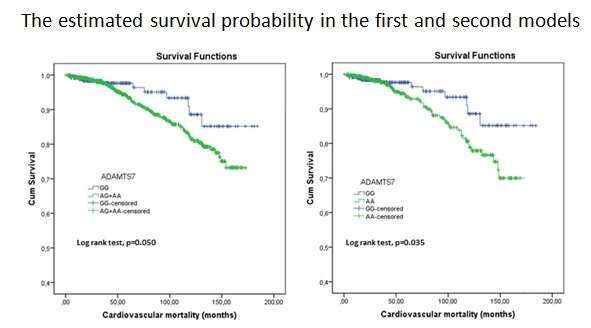
The Role of ADAMTS 7 Gene Variant rs3825807 A/G on Survival in Patients with Established Coronary Artery Disease
2Cardiology Department, New University of Lisbon, Faculty of Medical Sciences
ADAMTS7 is a regulator of the gene maturation, cartilage oligomeric matrix protein (COMP) cleavage, vascular smooth muscle cell (VSMC) migration and neointima formation. Consistently, genetic deletion of ADAMTS7 protects mice from atherosclerosis by reducing VMSC migration. A reduced genetic function of ADAMTS 7 can translate into fewer cardiovascular events, and better survival.
Aim: We proposed to demonstrate a significant association between the variant rs3825807 A>G, in the coding region of the ADAMTS7, and survival in patients with significant coronary artery disease (CAD).
Methods: A cohort of 1549 patients with angiographic proven CAD, who were followed up prospectively for a mean follow-up period of 55.8 (range 1.5 – 184.2) months, were genotyped for rs3825807 A/G. Two Kaplan-Meier (K-M) survival curves were performed according to ADAMTS7 genotypes for CV mortality. The first model compared AG+AA genotype with the GG genotype (Dominant model) and the second model compared the two homozygotes genotypes (AA vs. GG). A Cox regression analysis was performed in the second model adjusted for traditional risk factors (TRF) (hypertension, diabetes, dyslipidemia and smoking status)).
Results: 47.4% of patients were heterozygous (AG), 36% were homozygous for the wild-type allele (A) and only 16.6% were homozygous for the G protector allele. During the follow-up period, 156 (10.1%) patients died, being 107 (6.9%) of CV causes. The estimated survival probability (K-M) was 85.2% for GG genotype and 70% for AA genotype (p=0.035). After Cox regression we have confirmed that AA genotype was an independent risk factor for CV mortality compared with reference GG genotype (HR=1.892; 95% CI 1.000-3.673; p=0.050).
Conclusion: Further research in this area could lead to personalized medicine based on identification of ADAMTS7 genetic variants in patients with atherosclerosis who could benefit from strategies targeting this proteolytic pathway. ADAMTS7 represents a potentially exciting and novel therapeutic target for atherosclerosis.


Powered by Eventact EMS